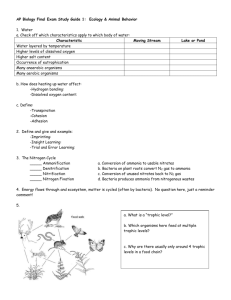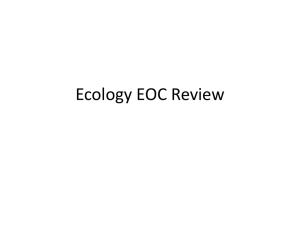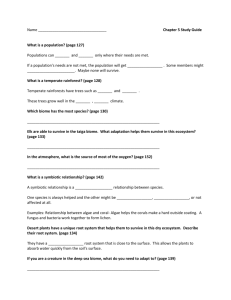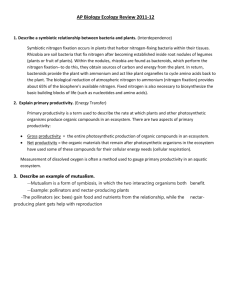chapter 18 SG ANSWERS (Intro to Ecology)
advertisement
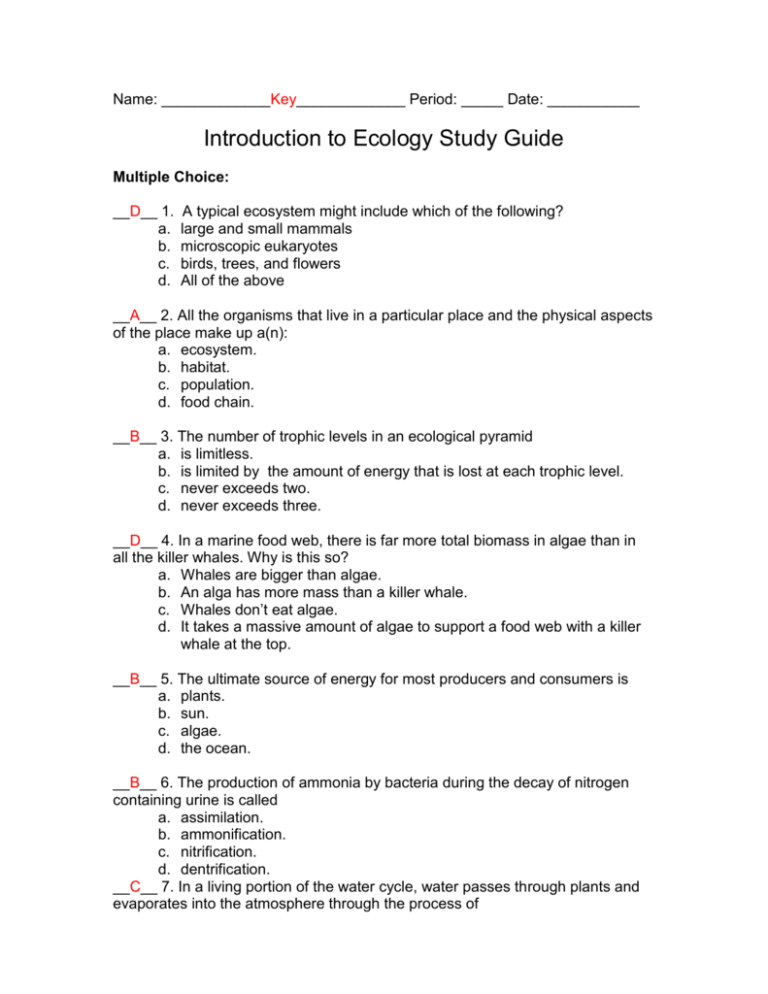
Name: _____________Key_____________ Period: _____ Date: ___________ Introduction to Ecology Study Guide Multiple Choice: __D__ 1. a. b. c. d. A typical ecosystem might include which of the following? large and small mammals microscopic eukaryotes birds, trees, and flowers All of the above __A__ 2. All the organisms that live in a particular place and the physical aspects of the place make up a(n): a. ecosystem. b. habitat. c. population. d. food chain. __B__ 3. The number of trophic levels in an ecological pyramid a. is limitless. b. is limited by the amount of energy that is lost at each trophic level. c. never exceeds two. d. never exceeds three. __D__ 4. In a marine food web, there is far more total biomass in algae than in all the killer whales. Why is this so? a. Whales are bigger than algae. b. An alga has more mass than a killer whale. c. Whales don’t eat algae. d. It takes a massive amount of algae to support a food web with a killer whale at the top. __B__ 5. The ultimate source of energy for most producers and consumers is a. plants. b. sun. c. algae. d. the ocean. __B__ 6. The production of ammonia by bacteria during the decay of nitrogen containing urine is called a. assimilation. b. ammonification. c. nitrification. d. dentrification. __C__ 7. In a living portion of the water cycle, water passes through plants and evaporates into the atmosphere through the process of a. b. c. d. photosynthesis. respiration. transpiration. nitrification. __D__ 8. The carbon in the remains of organisms that lived long ago is releases in the burning of a. wood. b. limestone. c. calcium carbonate. d. fossil fuels. __B__ 9. Most nitrogen-fixing bacteria live in a. the human intestine. b. soil and plant roots. c. rotting logs. d. the atmosphere. __B__ 10. An example of an abiotic factor is a. a tree. b. sunlight. c. a bird. d. grass. __B__ 11. Organisms’ that obtain their energy from the organic wastes and dead bodies that result from all the energy levels in an ecosystem are called a. omnivores. b. detritivores. c. herbivores. d. All of the above. __D__ 12. Which type of bacteria plays a significant role in the nitrogen cycle? a. nitrogen-fixing bacteria. b. decomposers. c. denitrifying bacteria. d. All of the above. __C__ 13. Caribou, musk oxen, snowy owls, and snowshoe hares are common animals in the a. desert. b. tropical rainforest. c. tundra. d. taiga. __B__ 14. About one-half of the world’s species are found in a. tropical dry forests. b. tropical rainforests. c. estuaries. d. temperate forests. Matching: __F__ 15. habitat __G__ 16. decomposers __D__ 17. net primary productivity __A__ 18. food web __B__ 19. trophic level __C__ 20. water __E__ 21. nitrogen a. complicated, interconnected group of food chains. b. indicates an organism’s position in a sequence of energy transfers. c. of abiotic factors, this has the greatest influence on an ecosystem’s inhabitants. d. the rate at which biomass accumulates. e. cycled throughout the living world primarily by bacteria. f. the place where an organism or population of organisms lives. g. release of nutrients back to the environment to be recycled by other organisms. Read each question carefully and write your answer in the space provided. 22. Why are energy pyramids always larger at the bottom than at the top? Only 10% of the energy is transferred from one level to the next. So producers make 100%, primary consumers receive 10%, secondary consumers get 1% and tertiary consumers only receive 0.1%. 23. Why are producers an essential component of an ecosystem? They are needed to provide energy for all the consumers. Without them there would be no way of converting sunlight or chemicals into carbohydrates. 24. What are the two methods by which autotrophs produce food? photosynthesis – using sunlight to make carbohydrates. chemosynthesis – using chemicals to make carbohydrates. 25. What does it mean when ecologists say that a species has a broad niche? They eat multiple things and can live in different places. They can easily adapt and survive in a variety of environments. 26. What is the tundra’s layer of soil in which the water is always ice is called? Permafrost Picture Analysis: Use the picture below to answer questions 27 -30. __D__ 27. The picture above represents a(n) ______. a. eating chart b. food chain c. net productivity diagram d. food web __C__ 28. What do ants eat? a. frogs, lizards, and centipedes b. centipedes c. sedge d. there is not enough information provided to make this conclusion. __D__ 29. What eats Maned geese? a. sedge b. lizards c. domestic cats d. there is not enough information provided to make this conclusion. __A__ 30. If Algae went extinct, how would this affect the other organisms? a. Tadpoles would not have their food source. b. Sedge and Daphnia would no longer have a key source of food. c. Most every organism would be affected, as they are all interconnected and indirectly has a link to all other organisms. d. Sedge, tadpoles, and daphnia would overpopulate. __B__ 31. Many vultures carry out _____ in which they _____. a. photosynthesis; use solar energy to power production of food. b. decomposition; make the nutrients that were contained in detritus available again to the autotrophs in the ecosystem. c. chemosynthesis; use energy stored in inorganic molecules to produce carbohydrates. d. both b and c. __D__ 32. Arrange the levels of organization from largest to smallest. a. Ecosystem, Biome, Biosphere, Community, Population b. Biome, Biosphere, Community, Ecosystem, Population c. Biosphere, Biome, Community, Population, Ecosystem d. Biosphere, Biome, Ecosystem, Community, Population Picture Interpretation Use the picture below to answer questions # 33-36. 33. Which cycle is pictured above? Water Cycle 34. Which process is labeled “A” AND DESCRIBE it. TRANSPIRATION – evaporation of water from plants’ leaves and stems. 35. Which process is labeled “B” AND give THREE EXAMPLES of it. PRECIPITATION – 1.rain 2.snow 3.sleet 4.hail 36. Name what “C” is AND DEFINE it. PERCOLATION – downward movement of water through soil and bedrock (permeable rocks)
